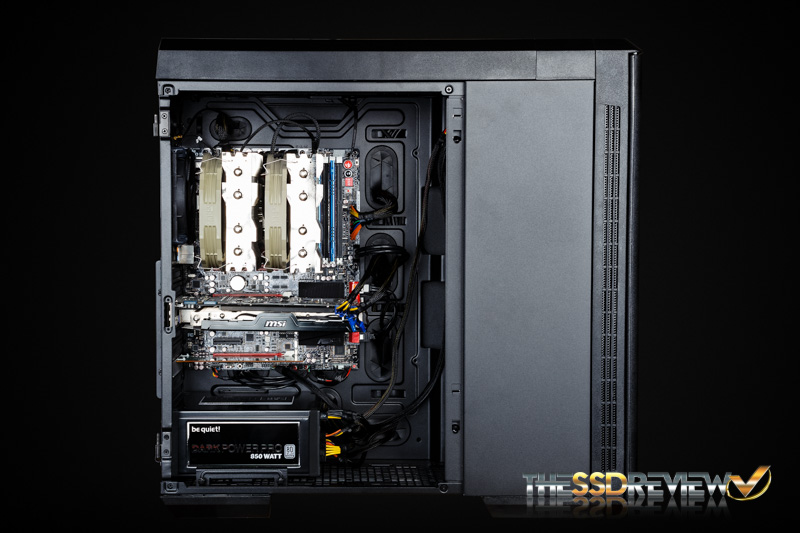TSSDR TEST BENCH AND PROTOCOL
SSD Testing at TSSDR differs slightly, depending on whether we are looking at consumer or enterprise SSDs. For consumer SSDs, our goal is to test in a system that has been optimized with our SSD Optimization Guide. To see the best performance possible the CPU C states have been disabled, C1E support has been disabled, Enhanced Intel SpeedStep Technology (EIST) has been disabled. Benchmarks for consumer testing are also benchmarks with a fresh drive so, not only can we verify that manufacturer specifications are in line but also, so the consumer can replicate our tests to confirm that they have an SSD that is top-notch. We even provide links to most of the benchmarks used in the report.
This is an updated test bench and, as such, we would love to thank those who jumped in specifically to help the cause. Key contributors to this build are our friends at ASUS for the motherboard and be quiet! for the PSU and cooling fans. Also, a big thank you to Thermaltake for the case. We have detailed all components in the table below and they are all linked should you wish to make a duplicate of our system as so many seem to do, or check out the price of any single component. As always, we appreciate your support in any purchase through our links!
SYSTEM COMPONENTS
This Test Bench build was the result of some great relationships and purchase; our appreciation goes to the below mentioned manufacturers for their support in our project. All of the components we use for testing and evaluation can be easily purchased at a relatively affordable price. The links provided below can assist in pricing, as well as availability for those of you who may find interest in our equipment.
| PC CHASSIS: | Thermaltake Urban T81 |
| MOTHERBOARD: | Asus Maximus VI Extreme |
| CPU: | Intel Core i5-4670K |
| CPU COOLER: | Thermalright Silver Arrow |
| POWER SUPPLY: | be quiet! Dark Power Pro 10 850W |
| SYSTEM COOLING: | be quiet! Silent Wings 2 |
| GRAPHICS CARD: | MSI GTX 660 Ti PE OC |
| MEMORY: | G.Skill Ares DDR3-1866Mhz Memory |
BENCHMARK SOFTWARE
The software we will be using for today’s analysis is typical of many of our reviews and consists of ATTO Disk Benchmark, Crystal Disk Info, Crystal Disk Mark, AS SSD, and Anvil’s Storage Utilities. In consumer reports, we prefer to test with easily accessible software that the consumer can obtain, and in many cases, we even provide links. Our selection of software allows each to build on the last and to provide validation to results already obtained.
Crystal Disk Info is a great tool for displaying the characteristics and health of storage devices. It displays everything from temperatures, to the number of hours the device has been powered, and even to the extent of informing you of the firmware of the device.
Crystal Disk Info shows us a lot of S.M.A.R.T. values, most of which are Vender Specific and of no use to us. Feature wise, it shows that DevSleep, TRIM, and NCQ are supported. we used a TRIM check tool on the drive, however the result was indeterminate for my Windows 7 OS and when it is connected to the ASMedia USB 3.0 port on my motherboard. However, TRIM should function for Macs.
ATTO Disk Benchmark is perhaps one of the oldest benchmarks going and is definitely the main staple for manufacturer performance specifications. ATTO uses RAW or compressible data and, for our benchmarks, we use a set length of 256mb and test both the read and write performance of various transfer sizes ranging from 0.5 to 8192kb. Manufacturers prefer this method of testing as it deals with raw (compressible) data rather than random (includes incompressible data) which, although more realistic, results in lower performance results.
After initial results from ATTO, I must say I’m impressed. This drive is only rated for up to 390MB/s write, however, in this benchmark we are seeing just over 450MB/s for both read and write!
 The SSD Review The Worlds Dedicated SSD Education and Review Resource |
The SSD Review The Worlds Dedicated SSD Education and Review Resource | 


The biggest advantage over the spinning hard disk, is, I think, the lower power demand. This means it can connect to a smartphone, tablet, etc – using just a USB (2 or 3) cable, without any other power source. Is this true, for simple read-writes?
I havent tried this with those cables…to a Smart phone.
I gave it a shot on my nexas 7. I couldn’t get my Android device to recognize/power up the drive with any of the USB mounting apps i tried.
Actually, some ssds have bigger power requirement than your standard 2.5″ 5400rpm drives. Lots of ssds can easily exceed 2.5W cap, usb2 offer in write intensive or random workload.
But its true, that in idle ssds tend to use less power.